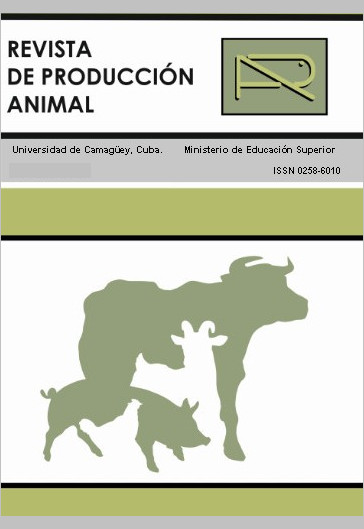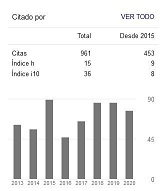Establishing New Cenchrus purpureus Varieties in a Fragile Ecosystem in the Cauto River Valley, Granma, Cuba
Resumen
Some indicators that determine the capacity to establish new varieties of Cenchrus purpureus (CT-801, CT-802, CT-803, CT-804, and CT-805), tolerant to droughts and salinity, in a fragile ecosystem in the province of Granma, Cuba, were evaluated. The study was made on the Cupeysito Basic State Farm, Manuel Fajardo Genetic Project, in Jiguaní, Granma. The five new varieties and variety Cuba CT-115 were used as controls in a randomized block design with four replicas. Shooting was controlled at different times of plantation, and the establishment cutting was made at 162 days, including the study of morphological and physiological variables, total DM yields and DM from leaves, leaf percent, and leaf/stem ratio. Cultivars CT-804 and CT-805 were higher (79%) than the control (CT-115) during shooting. The cultivars had similar height and stem thickness. The largest number of galls of CT-805 and CT-801 in relation to the progenitor CT-115 posed advantages for establishment. The new varieties, including CT-115, showed favorable levels of daily growth and low growth efficiency until the establishment cut was made, in the dry season. The progressive introduction of cultivars CT-801, CT-802, CT-803, CT-804, and CT-805 is recommended for their capacity to settle down in fragile ecosystems.
Descargas
Citas
ARGENTEL, L.; FONSECA, I.;GONZÁLEZ, L. M. y LÓPEZ, A. R. (2013). Efectos de la salinidad en las variables hídricas potenciales hídrico y osmótico y ajuste osmótico en cultivares cubanos de trigo (Triticum aestivum L. y T. durum L.). Revista de Cultivos Tropicales, 34(4), 43-48.
ARGENTEL, L.; GARANTUZA, J.; YÉPEZ, A. E.;SANTOS-VIILALOBOS, S. (2016). Evaluación de la tolerancia de variedades mexicanas de trigo a la salinidad, a través de indicadores fisiológicos, bioquímicos y agronómicos, cultivados en Cuba en condiciones de campo. Rev. Cultivos Trop.,37 (1), 91-101.
ARIAS, R. C (2012). Frecuencias de corte en cultivares promisorios de Pennisetum purpureum resistentes a la sequía con riego y fertilización orgánica. Tesis de maestría, Universidad de Granma, Bayamo, Cuba.
BENÍTEZ, D.; RAMÍREZ, A.; DÍAZ, M.; RAY, J.;GUERRA, J. yVEGAS, A. (2007). Comportamiento de machos vacunos en un sistema racional de pastoreo en el Valle del Cauto. Cuban Journal of Agricultural Science, 41 (3), 227-230.
BENÍTEZ, D, G.; CISNEROS, M.; PÉREZ-INFANTE, F. yNUVIOLA, Y. (2010a).El balance alimentario para los rebaños en pastoreo. Holguín, Cuba:Ed. ARGRAF.
BENÍTEZ, G. D.; CATASÚS, L. J.;ARIAS, R. C.; FAJARDO, R.; RAMÍREZ, A.et al. (2010b). Cultivares de pastos y forrajes tolerantes a los entornos adversos y degradados de la región oriental cubana. Holguín, Cuba: Ed. Dimitrov.
BELTRÁN, L. S.; HERNÁNDEZ, G. A.; GARCÍA, M. E.; PÉREZ, P. J.;KOHASHI, S. J.; HERRERA, H. J. G.et al. (2005).Efecto de la altura y frecuencia de corte en el crecimiento y rendimiento del pasto Buffel (Cenchrus ciliaris L.) en un invernadero. Agrociencia,39 (2), 137-147.
CORDOVÍ, E.; RAY, J. V.; NHATUMBO, S. y CHIMBALAMBALA, A. (2013). Comportamiento de tres especies del género Pennisetum purpureus en clima semiárido del sur de Mozambique. Revista Granma Ciencia,17(3), 31-34.
CRUZ, M.; CURBELO, L.;GUEVARA, R.; PEREDA, J.; MUÑÓZ, D.;TAMAYO, Y. et al. (2012). Evaluación Agronómica de tres gramíneas bajo condiciones edafoclimáticas. Revista Producción Animal,24 (2), 25-30.
DE ARMAS, V. R.; ORTEGA, D. E. yRÓDES, G. R. (1988). Fisiología Vegetal. La Habana, Cuba: Ed. Pueblo y Educación.
DÍAZ, D. (2007). Evaluación agronómica de nuevas variedades Pennisetum purpureum en condiciones de sequía el Valle del Cauto. Tesis de maestría, Universidad de Matanzas, Cuba.
FAJARDO, H. (2008). La innovación tecnológica en la producción pecuaria en la provincia de Granma: Una necesidad impostergable. Revista Electrónica Granma Ciencia,12(1) 20-23.
FERNÁNDEZ, M. J.; VIAMONTE, I. M.; FONSECA, N. yRAMÍREZ, A. (2015). Evaluación de dos cultivares de Pennisetum purpureum tolerantes a la sequía en la región de Cauto Cristo, Granma, Cuba. Rev. Ciencia y Tecnología Ganadera,9 (1), 23-29.
GARCÍA, L. M.; MESA, A. R.;HERNÁNDEZ, M. (2014). Potencial forrajero de cuatro cultivares de Pennisetum purpureum en un suelo Pardo de Las Tunas. Revista de Pastos y Forrajes,37 (4), 413-419.
GARDNER, F. P. yBRENT, P. R. L. (2000). Carbon fixation by crop canopies. Physiology of Crop Plants. EE.UU.: Iowa State University Press.
HERRERA, R. S. (2006).Fotosíntesis. Pastos tropicales, contribución a la Fisiología, establecimiento, rendimiento de biomasa, producción de biomasa, producción de semillas y reciclaje de nutrientes.La Habana, Cuba:Ed. EDICA-ICA.
HINOJOSA, L.A.;YÉPEZ, N. D.; RODAL, C. F.;RÍOS, A.; CLAROS, B. R.; SUÁREZ, N. T.et al.(2014). Producción y características agronómicas de cuatro variedades de pasto de corte del genero Pennisetum, en Trinidad, Bolivia. Rev. Cient. Agro. Amaz.,20 (3), 28-35. Retrieved on February 20, 2014, from http://www.revistasbolivianas.org.bo/scielo.php?script=sci_arttext&pid=S2307-96062014000100004&lng=es&nrm=iso.
MURILLO, L.; CHACÓN, E.; DE LA RIVERA, J.;ÁLVAREZ, G., ÁLVAREZ, P., PLÚA, K.et al. (2015). Rendimiento y calidad de las especies del género Pennisetum en Ecuador. REDVET,16 (8), 1-10.
KEULS, M. (1952). The Use of the Studentized Range in Connection with an Analysis of Variance. Euphytica, 1(2), 112-122.
ONEI (2014). Anuario estadístico de Cuba. Territorio. Cuba:Oficina Nacional de Estadística e Información. Re-trieved on February 20, 2014, fromhttp://www.one.cu/anuarioestadisticodecuba2014.
PARETAS, J. J. y RIVERO, R. (1990). Ecosistemas y Regionalización de pastos en Cuba. En Paretas, J. J. (Eds)Metodología para la regionalización de gramíneas. La Habana, Cuba. Ed. MINAG-Instituto de Investigaciones de Pastos y Forrajes.
RAMÍREZ, J. L. (2010). Rendimiento y calidad de cinco gramíneas en el Valle del Cauto. Tesis de doctorado, Instituto de Ciencia Animal, Mayabeque, Cuba.
STATGRAPHICS (2014). Statgraphics CenturionXV.II versión 15.02.6. StatPoint, Inc.
UVIDIA, H.; LEONARD, I.; BENÍTEZ, D. yBUESTAN, D. (2013). Dinámica del crecimiento de la Maralfalfa (Pennisetum sp), en condiciones de la Amazonia Ecuatoriana. Rev Amazónica: Ciencia y Tecnología,2 (1), 14-18.
ZEWDU, T.; BAARS, R. M. T. yYAMI, A. (2002). Effect of Plant Height at Cutting, Source and Level of Fertilizer on Yield and Nutritional Quality of Napier grass (Pennisetum purpureum L. Schumach). African Journal of Range and Forage Science, 19(2), 123-128.
Los autores de los artículos publicados en RPA retienen los derechos de autor de su trabajo, de marca y patente, y también sobre cualquier proceso o procedimiento descrito en el artículo, así como a compartir, copiar, distribuir, ejecutar y comunicar públicamente el artículo publicado en la RPA o cualquier parte de aquel siempre que indiquen la fuente de publicación (autores del trabajo, revista, volumen, número y fecha), pero están de acuerdo en que la revista publique los trabajos bajo una licencia Creative Commons.
![]() Licencia Attribution-NonCommercial 4.0 International (CC BY-NC 4.0)
Licencia Attribution-NonCommercial 4.0 International (CC BY-NC 4.0)






































